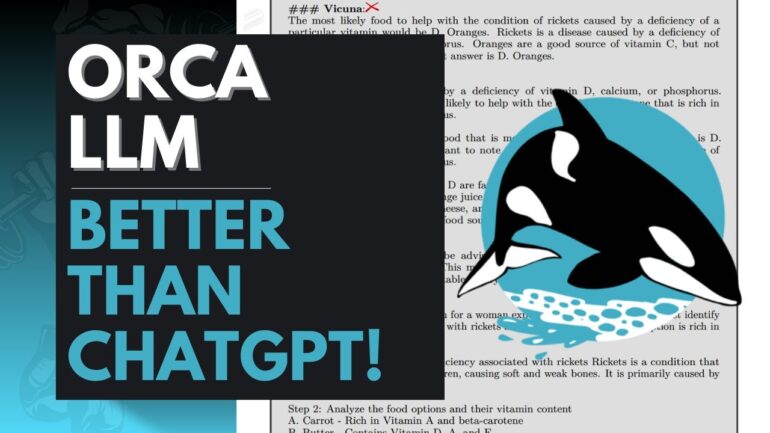TL;DR:
- Orca is a 13-billion parameter model designed to simulate the reasoning processes of large language models (LLMs) like GPT-4.
- It employs a unique training approach, combining progressive learning and teacher assistance.
- Orca’s training process consists of two stages: training on FLAN-5M with ChatGPT augmentations, followed by training on FLAN-1M with GPT-4 augmentations.
- Advantages of Orca’s methodology include bridging the capacity gap between smaller and larger models, incremental knowledge building, and improved reasoning abilities.
- Orca outperforms traditional models in complex zero-shot reasoning benchmarks and shows competitive performance on professional and academic exams.
- The development of Orca opens up possibilities for enhanced performance in tasks requiring complex reasoning and problem-solving.
Main AI News:
In the ever-evolving landscape of large language models (LLMs), there is a constant drive to enhance the capabilities of smaller models while maintaining their efficiency. Traditionally, the approach has been to employ imitation learning, where smaller models learn from the outputs generated by large foundation models (LFMs). However, this approach has encountered numerous challenges, including limited imitation signals from shallow LFM outputs, small-scale homogeneous training data, and a lack of rigorous evaluation. As a result, smaller models often excel in imitating the style of LFMs but struggle to replicate their intricate reasoning processes.
A breakthrough paper titled “Orca: Progressive Learning from Complex Explanation Traces of GPT-4” introduces a revolutionary model, Orca, boasting a staggering 13 billion parameters. Its purpose is to imitate the reasoning process of large foundation models such as GPT-4. Unlike traditional large language models (LLMs), Orca employs a unique training approach that combines progressive learning and teacher assistance, effectively bridging the capacity gap between smaller student models and their larger counterparts.
Let’s delve into the methodology behind Orca’s training process
Orca’s training process consists of two stages, each contributing to its remarkable capabilities. In the first stage, Orca undergoes training on FLAN-5M, a dataset enriched with ChatGPT augmentations. This intermediate teacher assistant plays a crucial role in bridging the capacity gap between Orca and the vastly parameter-rich GPT-4. Leveraging the remarkable capabilities of ChatGPT, Orca benefits from significantly improved imitation learning performance, honing its skills in the process.
Moving to the second stage, Orca’s training continues with FLAN-1M, which incorporates GPT-4 augmentations. This stage follows a curriculum learning paradigm, where Orca progressively learns from easier examples before gradually tackling more challenging ones. By exposing Orca to increasingly complex reasoning tasks and providing step-by-step explanations, the model continually enhances its reasoning abilities and mimicking skills.
The advantages and contributions of Orca’s training methodology are truly impressive
First and foremost, Orca effectively addresses the capacity gap issue by utilizing an intermediate teacher model. This unique approach allows Orca to learn from a more capable source, resulting in improved imitation learning performance for smaller student models. By tapping into the vast knowledge of ChatGPT, Orca gains valuable insights and refines its reasoning process.
Additionally, Orca’s training methodology embraces progressive learning, empowering the model to incrementally build upon its existing knowledge. By starting with simpler examples and gradually introducing more complex ones, Orca establishes a solid foundation for advanced reasoning and explanation generation. This gradual progression equips Orca with the skills required to tackle intricate tasks effectively.
Furthermore, Orca’s remarkable ability to imitate the reasoning process of LFMs like GPT-4 unlocks a world of possibilities for enhanced performance across a wide range of tasks. By leveraging the rich signals provided by GPT-4’s explanation traces and step-by-step thought processes, Orca gains invaluable insights, thereby improving its own capabilities.
The performance benchmarks achieved by Orca are nothing short of extraordinary
In complex zero-shot reasoning benchmarks, Orca has showcased exceptional performance. It surpasses traditional state-of-the-art instruction-tuned models like Vicuna-13B by an astounding 100% on benchmarks like Big-Bench Hard (BBH) and an impressive 42% on AGIEval. Furthermore, Orca achieves scores comparable to ChatGPT on the BBH benchmarks, demonstrating its prowess. Even in professional and academic exams such as the SAT, LSAT, GRE, and GMAT, Orca performs competitively, despite operating in zero-shot settings without chain-of-thought. This achievement is particularly noteworthy, considering that Orca lags behind GPT-4 while still delivering commendable results.
The implications and future directions resulting from the development of Orca are profound
Orca represents a significant leap forward in the field of LLMs. By learning from rich signals and emulating the reasoning process of LFMs, Orca showcases an exceptional ability to perform complex reasoning tasks with a remarkable degree of accuracy. This breakthrough has far-reaching implications, particularly in domains that demand intricate reasoning and problem-solving.
Furthermore, this research highlights the promise of learning from step-by-step AI model explanations as a means to enhance model capabilities. It opens up exciting avenues for further research and development in the field of LLMs, propelling the boundaries of what can be achieved.
Conclusion:
The development of Orca LLM represents a significant advancement in the market of large language models. By successfully imitating the reasoning processes of large foundation models like GPT-4, Orca demonstrates its potential to perform complex reasoning tasks with a high degree of accuracy. This breakthrough has profound implications across various industries where intricate problem-solving and reasoning skills are essential.
Furthermore, the progressive learning methodology employed by Orca addresses the capacity gap issue and offers improved performance for smaller student models. The market can expect increased capabilities and enhanced performance in language understanding, generation, and problem-solving applications as a result of Orca’s groundbreaking approach. This underscores the importance of continued research and development in the field of large language models, with a focus on reasoning-focused learning approaches.

